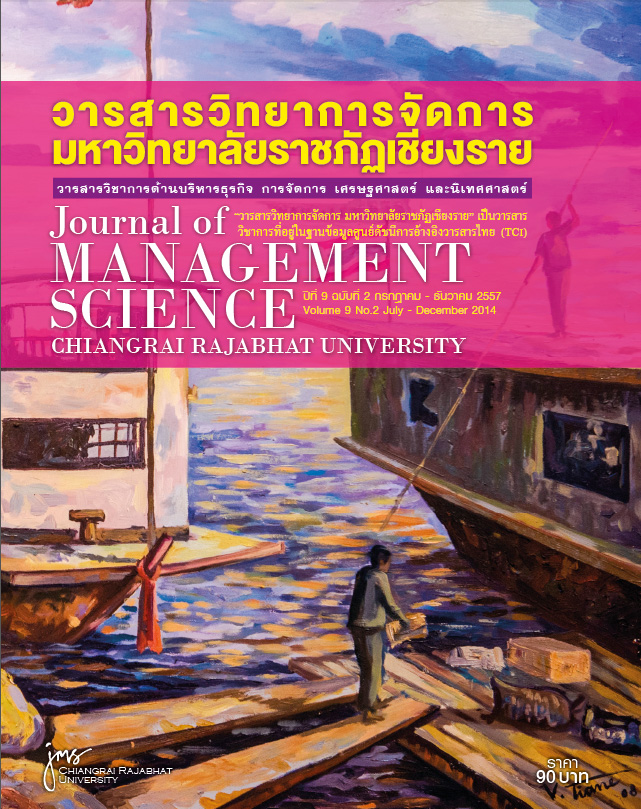ความสัมพันธ์เชิงสาเหตุระหว่างภาวะการประกอบการ ความสามารถทางการตลาด นวัตกรรม และกลยุทธ์ธุรกิจที่ส่งผลต่อความได้เปรียบในการแข่งขันของวิสาหกิจ ขนาดกลางและขนาดย่อม กลุ่มล้านนาของประเทศไทย
Main Article Content
บทคัดย่อ
การศึกษาความสัมพันธ์เชิงสาเหตุระหว่างภาวะการประกอบการ ความสามารถทางการตลาด นวัตกรรมและกลยุทธ์ธุรกิจที่ส่งผลต่อความได้เปรียบในการแข่งขันของวิสาหกิจขนาดกลางและขนาดย่อม กลุ่มล้านนาของประเทศไทย เป็นการวิจัยแบบผสมผสาน กลุ่มตัวอย่าง คือ ผู้ประกอบการวิสาหกิจขนาดกลางและขนาดย่อม 8 จังหวัด ได้แก่ เชียงราย เชียงใหม่ น่าน พะเยา แพร่ แม่ฮ่องสอน ลำปาง และลำพูน จำนวน 465 ราย สุ่มตัวอย่างแบบแบ่งชั้นภูมิ วิเคราะห์ข้อมูลด้วยสถิติเชิงพรรณนา เพื่อหาค่าร้อยละ ค่าเฉลี่ย ค่าเบี่ยงเบนมาตรฐาน รวมถึงวิเคราะห์เนื้อหา สถิติอนุมานวิเคราะห์ด้วยตัวแบบสมการโครงสร้าง ผลการวิเคราะห์ความสัมพันธ์เชิงสาเหตุพบว่า ภาวะการประกอบการมีอิทธิพลทางตรงต่อความสามารถทางการตลาดมากที่สุด รองลงมา คือ ภาวะการประกอบการมีอิทธิพลทางตรงต่อกลยุทธ์ธุรกิจ ลำดับสุดท้าย คือ ภาวะการประกอบการมีอิทธิพลทางตรงต่อนวัตกรรม ส่วนปัจจัยภาวะการประกอบการ มีความสัมพันธ์ทางอ้อมต่อความได้เปรียบในการแข่งขันผ่านความสามารถทางการตลาด นวัตกรรมและ กลยุทธ์ธุรกิจ ปัจจัยความสามารถทางการตลาดมีอิทธิพลทางตรงต่อนวัตกรรมและความได้เปรียบในการแข่งขัน นวัตกรรมมีอิทธิพลทางตรงต่อความได้เปรียบในการแข่งขัน และกลยุทธ์ธุรกิจ ลำดับสุดท้าย กลยุทธ์ธุรกิจ มีอิทธิพลทางตรงต่อความได้เปรียบในการแข่งขัน การวิจัยนี้ค้นพบทฤษฎีกลยุทธ์ของธุรกิจขนาดกลางและขนาดย่อม สรุปได้ว่าความได้เปรียบในการแข่งขันของธุรกิจขนาดกลางและขนาดย่อมเกิดจากภาวะการประกอบการ และการกำหนดกลยุทธ์ธุรกิจที่เหมาะสมของผู้ประกอบการ
Article Details
ทัศนะและข้อคิดเห็นของบทความที่ปรากฏในวารสารฉบับนี้เป็นของผู้เขียนแต่ละท่าน ไม่ถือว่าเป็นทัศนะและความรับผิดชอบของกองบรรณาธิการ
References
ส่งเสริมวิสาหกิจขนาดกลางและขนาดย่อม (สสว.).
_______. (2556). รายงานสถานการณ์วิสาหกิจขนาดกลางและขนาดย่อม ปี 2556 และแนวโน้มปี 2557.กรุงเทพฯ:สำนักงานส่งเสริมวิสาหกิจขนาดกลางและขนาดย่อม(สสว.) Afzal,S. (2010).“Marketing Capability,Strategy and Business Performance in Emerging Markets of Pakistan,”IUB Journal of Social Sciences and Humanities.7(2):88-102. Bannock, G. (2005). The Economics and Management of Small Business: An International Perspective. London : Routledge. Bougheas,S. , Mizen,P. , & Yalcin, C. (2006). “Access to external finance: Theory and evidence on the impact of monetary policy and firm-specific characteristics,” Journal of Banking and Finance. 30: 199-227. Bygrave, W. D. , & Hofer, C. W. (1991). “Theorizing about entrepreneurship,” Entrepreneurship Theory and Practice.16(2) : 13-22. Chen, M. , & Hambrick, D. C. (1995). “Speed, stealth, and selective attach: How small firms differ from large firms in competitive behavior,” Academy of Management Journal. 38(2) : 453–482. Covin, J. G. , & Slevin, D.P. (1991). “A conceptual model of entrepreneurship as firm behaviour,” Entrepreneurship Theory and Practice. 16(1) : 7-25. Damanpour,F. ,Szabat, K. A. , & Evan,W.M. . (1989).“Therelationshipbetweentypes of innovation and organizational performance,” Journal of Management Studies. 26(6) : 587-601. Gibbons, A. (1997).Innovation and the Developing System of Knowledge Production. University ofSussex. Halit, K. (2006).“Marketorientation, learningorientation,andinnovationcapabilities in SMEs an extended model,” European Journal of Innovation Management. 9(4) : 396-417. Johne, A. (1999). “Successful market innovation,” European Journal of Innovation Management.2 :6-11. Klongan, G. E. , & Goward, E. W. (1976). Rural Sociology. Bangkok: M.S. Thesis Kasetsart University. Kuratko, D. F. , & Hodgetts, R. M. (2004). Entrepreneurship: Theory, Process and Practice. Mason, Ohio: ThomsonSouth-Western. Liu, S. , Luo, X. , & Shi, Y. (2002). “Integrating customer orientation, corporate entrepreneurship, and learning orientation in organization-in-transition: An empirical study,” Internal Journal of Research in Marketing. 19: 367-382. Low, M. B. , & MacMillan, I. C. (1988). “Entrepreneurship: Past research and future challenges,” Journal of Management.14: 139-162.
Miles, R. , & Snow, C. (1978). Organizational Strategy, Structure and Process. New York: McGraw Hill. Morgan, N. A. , Vorhies, D.W. , &Mason, C. H. (2009).“Marketorientation, marketing capabilities and firm performance,” Strategic Management Journal. 30(8) :
909–920. Michaels, E. T. , & Gow, H. R. (2008). “Market orientation, innovation and entrepreneurship: An empirical examination of illinois beef industry,” International Food and Agribusiness Management Review. 11(3) : 56-61. Moreno, A. M. , & Casillas, J. C. (2008). “Entrepreneurial orientation and growth of SMEs: A causal model,” Entrepreneurship Theory and Practice. 32:507–528. Porter, M. E. (1980). Competitive Strategy. New York: TheFreePress. PorterM. E. (1985). Competitive Strategy: Techniques for Analyzing Industries and Competitors. New York, NY:TheFreePress. Porter, M. E. (1996). What is strategy? Harvard Business Review, 74(6): 61-78. Porter, M. E. (1998). On Competition, Boston: Harvard BusinessSchool. Ringle, C.M. ,Wende,S. , &Will, A.(2004).Smart PLS 2.0 (M3). [Online] Available:http://www.smartpls.de/. Retrieved [2011, October 3]. Rizzoni, A. (1991). “Technological innovation and small firms: a taxonomy,” International Small Business Journal.9(3) : 79-91. Schumpeter, J. (1994). A History of Economic Analysis. London: Routledge. Schumpeter, J. A. (1950). Capitalism, Socialism and Democracy(3rd ed.). New York:Harper and Row. Shahid, Q. (2010). “Antecedents and outcomes of entrepreneurial firms marketing capabilities: An empirical investigation of small technology based firms,” Journal of Strategic Innovation and Sustainability.6(4). Weerawardena, J. (2003). “The role of marketing capability in innovation – based competitiveStrategy,” Journal of Strategy Marketing. 11 :15-35.

